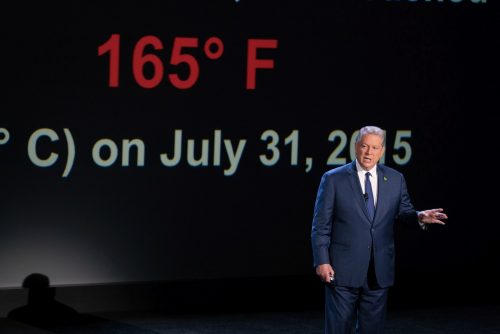Al Gore’s Oscar-winning An Inconvenient Truth brought climate change to the forefront of mainstream culture, but now, ten years on, the stakes have been raised higher, making his follow-up feature an even hotter topic, sadly both metaphorically and literally.
The Inconvenient Sequel follows the former Vice President as he continues his tireless work around the globe to educate and inspire the next generation of climate champions. His ‘can do’ attitude is genuinely uplifting, especially as he explains that the solutions to the climate crisis are still within our reach (did you know that wind energy could supply 40 times more electricity than the entire world currently uses?!). However, the very concept of climate change is still terrifying, which is why we ALL need to watch and listen to this incredible documentary. Here are just ten reasons why…
- We’re putting 110 million tons of man-made global warming pollution into the atmosphere every single day. That pollution – especially carbon dioxide, is building up and trapping heat, driving the temperature up.
- Scarily, 16 of the 17 hottest years on record have occurred since 2001, with 2016 the hottest yet.
- On a global basis, more than 90 per cent of all the extra heat energy trapped by our atmosphere is going into the oceans. This heat makes ocean-based storms like hurricanes, typhoons and cyclones stronger and more destructive. This won’t be a surprise to anyone who’s seen the headlines this year though.
- It gets a bit science-like, but the extra heat also disrupts the water cycle, as the amount of water vapour that evaporates off the oceans increases as the oceans warm. That vapour is carried over the land and often falls more heavily. When the land can’t absorb all the water, we see floods and mudslides. We’ve seen the evidence.
- Wondering how global warming can be blamed for causing both more flooding AND more drought? That same extra heat that evaporates more water from the ocean pulls moisture even more quickly from the soil, causing longer and deeper droughts.
- The number of climate-related extreme weather events has been going up worldwide, according to the insurance industry. In 2016 alone these disasters caused losses over $175 billion.
- Wondering about the credentials of climate change data? NASA has precisely measured the decline in the mass of ice in both Greenland and Antarctica.
- Heat stress is now beginning to decrease crop yields from rice and corn and soybeans. Exposure to higher levels of carbon dioxide also decreases the nutrient content of many staple crops such as rice, wheat and soy.
- Warmer temperatures have an impact on the spread of tropical diseases, too. The potential range of these expands as regions farther and farther poleward get warmer. This means there are more and more places where a disease like Zika can take root.
- Climate change, along with other factors such as ecosystem loss, is contributing to the worst extinction event since the extinction of the dinosaurs 65 million years ago.






































